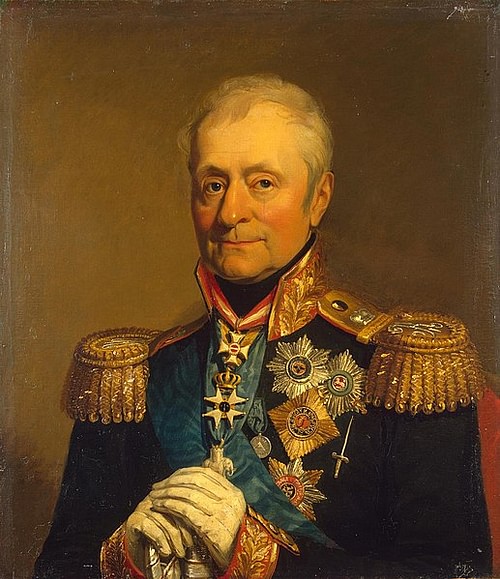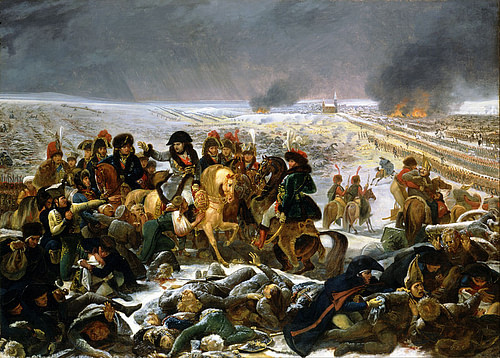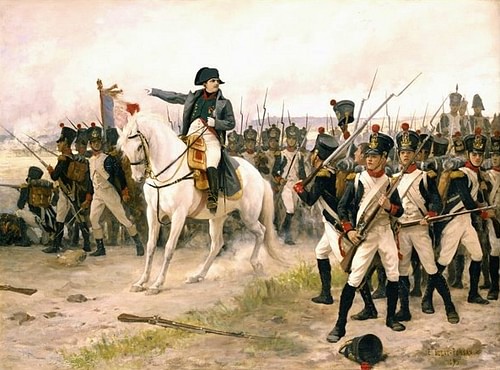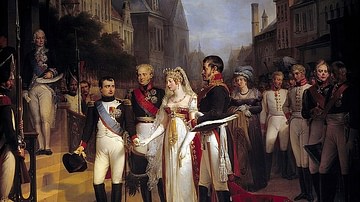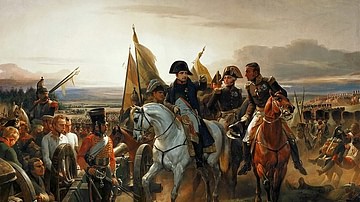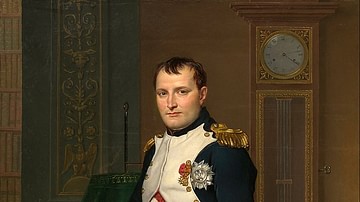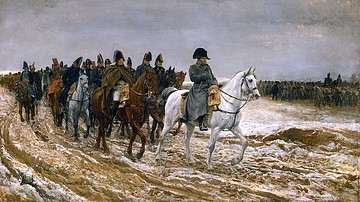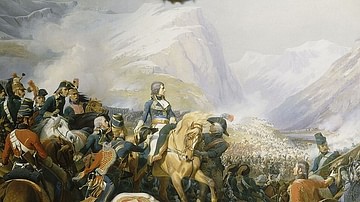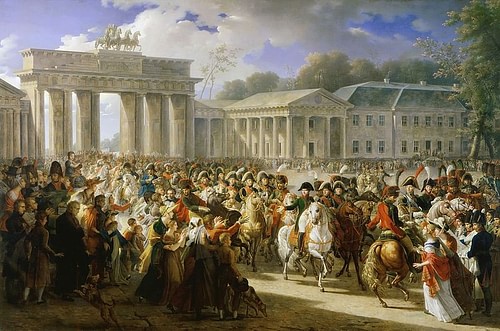
The War of the Fourth Coalition (October 1806 to June 1807) was a major conflict during the Napoleonic Wars (1803-1815). The Fourth Coalition consisted of Russia, Prussia, Saxony, Sweden, and the United Kingdom, against the First French Empire, the Confederation of the Rhine, Polish rebels, and Spain. The war resulted in a French victory, solidified by the Treaties of Tilsit.
While most historians consider the previous Napoleonic conflict, the War of the Third Coalition, to have ended by July 1806, there was no general peace between the third and fourth coalition wars; Russia, Sweden, and the United Kingdom remained at war with France the entire time. The birth of the Fourth Coalition, therefore, is often marked by Prussia's entry into the war. Though Prussia had stayed neutral during the previous eleven years of war, concerns over France's rising hegemony in Central Europe led King Frederick William III of Prussia (r. 1797-1840) to declare war on French Emperor Napoleon I (r.1804-1814; 1815) on 9 October 1806. But the Prussians were woefully underprepared and were soundly defeated by the French Grande Armée at the double Battle of Jena-Auerstedt (14 October). Berlin fell to the French two weeks later.
After Prussia's defeat, Saxony switched sides and joined the Confederation of the Rhine, a league of German states under Napoleon's protection. In December 1806, the Grande Armée crossed the Vistula River and engaged the Russian army in a bitter campaign that culminated in the inconclusive Battle of Eylau (7-8 February 1807). With neither side winning much of an advantage, the French and Russian armies withdrew into winter quarters only to clash again four months later at the Battle of Friedland (14 June 1807). This time, the Russians were decisively defeated. On 25 June, Napoleon met with Tsar Alexander I of Russia (r. 1801-1825) on a raft in the middle of the Niemen River; the resulting Treaties of Tilsit ended the War of the Fourth Coalition, resulting in a Franco-Russian alliance and the reduction of Prussia to a second-rate power. The end of the war saw Napoleon at the height of his power, master of most of Western and Central Europe.
Background
On 2 December 1805, Napoleon's Grande Armée shattered an Austro-Russian force at the Battle of Austerlitz. As the broken Russian army limped back into Hungary, Austria sued for peace, exiting the war on 26 December after ceding significant territory to Napoleon's allies. The following March, the French ousted the House of Bourbon from the throne of Naples, which was handed to Napoleon's brother, Joseph Bonaparte. Although Britain, Russia, and Sweden fought on, the Third Coalition was dead, and the triumphant Napoleon was left to redraw the map of Europe. In July 1806, he established the Confederation of the Rhine, a league of German states under French protection that included Bavaria, Württemberg, Baden, and several others. Since these states were required to leave the Holy Roman Empire, this directly resulted in the empire's dissolution, dramatically shifting the balance of power in Central Europe.
This disturbed the Kingdom of Prussia, whose own dominance of northern Germany was now challenged. Since 1795, Prussia had managed to stay neutral in the French Revolutionary and Napoleonic wars, though this stance had become increasingly difficult as the tendrils of French influence spread into Germany. At the start of the War of the Third Coalition, France persuaded Prussia to maintain its neutrality by offering to give it Hanover. However, several Prussian ministers recognized the danger that France posed to Prussian interests, and a war party soon formed in Berlin, centered around the queen consort Louise of Prussia (l. 1776-1810). In early October 1805, Queen Louise's war party gained traction when French soldiers crossed through the Prussian territory of Ansbach without permission on their way to attack Austria; this blatant violation of Prussia's sovereignty enraged Prussian officials. At the urging of his wife, King Frederick William III began mobilizing his armies. The Prussian king agreed to mediate peace talks between France and the Coalition powers and secretly promised to join the war against Napoleon if such talks failed. However, before the Prussians could finish mobilizing, Napoleon triumphed at Austerlitz and the Third Coalition unraveled shortly thereafter.
Napoleon attempted to assuage Prussian concerns over his new Confederation of the Rhine by giving his blessing for the creation of a Prussian-dominated North German Confederation as a counterbalance. But any trust the Prussians had in Napoleon was dashed when the French emperor offered to cede Hanover to King George III of Great Britain, utterly disregarding the neutrality deal he had previously made with Prussia. Tensions worsened in August 1806, when Napoleon ordered the arrest and summary execution of Johann Philipp Palm, a German nationalist and bookseller who published anti-Napoleonic pamphlets that denounced the French occupation of German lands. Palm's execution sparked outrage across the German-speaking world. In Berlin, Prussian officers went so far as to provocatively sharpen their sabers on the steps of the French Embassy.
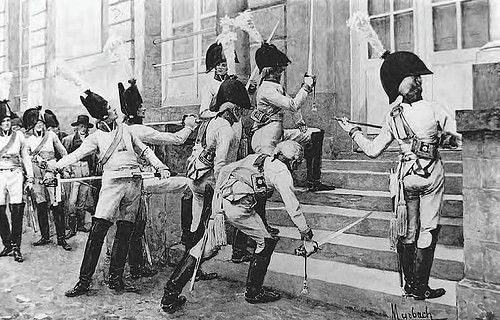
Frederick William could no longer ignore the outcry for war. In August 1806, he once again began mobilizing his army. Napoleon anticipated the declaration of war and began massing his troops along the southern border of Saxony. On 1 October 1806, Prussia issued an ultimatum, demanding the withdrawal of all French troops across the Rhine and the recognition of a North German Confederation under Prussian control. When Napoleon failed to respond, Frederick William formally declared war on 9 October, joined by his ally, the Electorate of Saxony. Together with Russia, Sweden, and Britain, these nations formed the Fourth Coalition.
Prussian Campaign
On 8 October 1806, a day before the official declaration of war, Napoleon's Grande Armée crossed over into Saxony. Guided by the Cavalry Reserve under Marshal Joachim Murat, the French army moved in a massive bataillon carré (battalion square) formation, advancing in three parallel columns. With 160,000 soldiers and 32,000 cavalry, the Grande Armée of 1806 was perhaps the "most integrated and best trained force that Napoleon ever commanded", its soldiers hardened veterans who had been tempered on the battlefields of Ulm and Austerlitz (Chandler, 454). The Prussian soldiers, by contrast, were largely inexperienced, and even the commanders had not seen a battle in over a decade. Whereas the French Grande Armée was the most modern and efficient fighting force in Europe, the Prussian army had not been updated since the days of Frederick the Great.
The first major action of the campaign took place on 10 October, when French Marshal Jean Lannes' V Corps, leading the leftmost French column, approached the town of Saalfeld. Here, they encountered the Prussian advance guard under Prince Louis Ferdinand, a nephew of the Prussian king. Although he was outnumbered, the prince decided to hold his ground and opened fire on the French troops as they emerged from the woods. After hours of desperate fighting, the French gained the upper hand, and Prince Louis Ferdinand was killed as he led a charge against the French center. At the loss of 1,700 men, the Prussian advance guard fled back across the Saale River, the defeat delivering a major blow to Prussian morale. The Prussian commander-in-chief, Charles William Ferdinand, Duke of Brunswick (1735-1806) held a war council, where it was decided that Brunswick's main army of 65,000 men would beat a northeasterly retreat toward Leipzig. Their retreat would be covered by a rearguard under Prince Hohenlohe, positioned near the town of Jena.
Napoleon, meanwhile, correctly surmised that the concentration of Prussian forces in the Erfurt-Weimar area precipitated a movement to the northeast. However, he mistakenly believed that it was Brunswick's main force encamped at Jena, rather than just the Prussian rearguard. On 13 October, Napoleon ordered his main army to prepare an attack on Jena. He ordered two corps, under marshals Louis-Nicolas Davout and Jean Bernadotte, to march to the north to fall upon the enemy rear. Battle was joined at Jena the next morning. Hohenlohe's 38,000 Prussians put up a fierce fight but were unable to withstand the 96,000 French soldiers; by 2:30 pm, Hohenlohe's entire army was in flight. For hours, the fleeing Prussians were relentlessly pursued and cut down by Murat's cavalry.
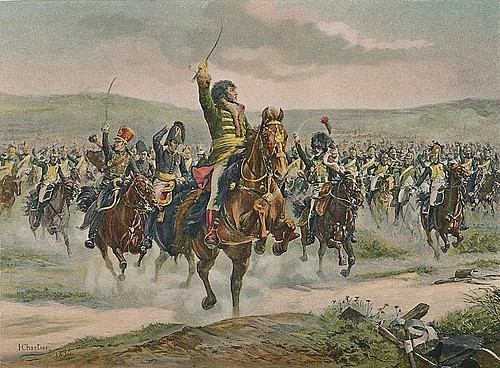
Meanwhile, near Auerstedt, Marshal Davout's III Corps of 15,000 men encountered Brunswick's main army. Although he was hopelessly outnumbered, Davout stood his ground; despite losing a quarter of its strength, his III Corps withstood several Prussian assaults. Before long, the Duke of Brunswick was mortally wounded and most of the other senior Prussian commanders were wounded or captured. Noticing that the enemy was confused and demoralized, Davout ordered a countercharge, which succeeded in breaking the Prussian line. The twin battles of Jena and Auerstedt succeeded in breaking Prussia's will to fight; in the following days, French troops spread across Prussia, capturing key fortresses often without having to fire a shot. On 25 October, the French occupied Berlin, with Davout's III Corps given the honor of entering first.
With the fall of Berlin, Prussia was effectively knocked out of the war; in just 19 days, the Prussians had lost 65,000 casualties and 150,000 prisoners, compared to only 15,000 French casualties. Entering Berlin a day after Davout, Napoleon apparently visited the tomb of Frederick the Great, remarking to his marshals, "If this man were alive, I would not be standing here now" (Roberts, 423). As the French continued to mop up Prussian resistance, marshals Bernadotte, Soult, and Murat chased a Prussian corps under Gebhard von Blücher to Lübeck in the so-called 'pursuit of the three marshals'. Blücher capitulated on 7 November, as the city of Lübeck fell victim to pillaging. Marshal Bernadotte did his best to limit the excesses of the plundering and even allowed a surrendered detachment of 1,600 Swedish soldiers to return home. The Swedes would not forget the leniency shown by Bernadotte, which became a major factor in their later decision to elect him their crown prince.
Polish Campaign
Refusing to surrender, King Frederick William and his court fled for the safety of Königsberg in East Prussia (modern Kaliningrad, Russia) to link with the approaching Russian army. Before he left Germany to pursue, Napoleon issued the Berlin Decree on 21 November 1806; this decree instituted a large-scale embargo of British goods in all territories that were either administered by or allied to the French Empire. This embargo would soon be known as the Continental System. On 11 December, Napoleon reached an agreement with the Electorate of Saxony, whereby Saxony left the Fourth Coalition and joined Napoleon's Confederation of the Rhine and, in return, was elevated to the rank of kingdom.
Napoleon then set out for Prussian-occupied Poland, which was already in the midst of a popular uprising, brought on by anti-conscription rioting. Entering Warsaw on 19 December, Napoleon was greeted with fanfare by the local Polish population, who hailed him as a liberator. The Poles had been deprived of their nationhood by the three partitions of Poland (in 1772, 1793, and 1795), which had divided up Polish lands between Prussia, Russia, and Austria. Now, the Poles saw Napoleon as the man to help them win back their freedom. Although he was careful not to make any explicit promises, Napoleon relished his role as Poland's deliverer and saw the value of a French client state on Russia's doorstep. He reorganized six Polish departments into a semi-autonomous political entity overseen by a council of seven Polish nobles. This polity would soon become the Grand Duchy of Warsaw, ruled by Napoleon's new ally King Frederick Augustus of Saxony.
Napoleon next turned his attention toward the Russian army under Count Mikhail Kamensky, which had pulled back to Pułtusk, north of Warsaw. With the goal of defeating Kamensky's army before pushing on to capture the temporary Prussian capital of Königsberg, Napoleon ordered the Grande Armée across the Vistula River. Fighting began on 23 December, when Davout's Corps launched a successful night attack on 15,000 Russians who were guarding a crossing over the River Wkra at Czarnowo. Davout seized the crossing for the price of 1,400 casualties on each side. On 26 December, the French and Russians clashed in the battles of Pułtusk and Gołymin; despite heavy casualties, neither battle proved decisive. With the rapid onset of winter, both armies then settled into winter quarters. Having incurred the wrath of the tsar with his inactivity, Kamensky was pressured into resigning; he was replaced as commander-in-chief by the German-born Count Levin August von Bennigsen.
Napoleon, meanwhile, returned to Warsaw as his men wintered along the Vistula. By early January 1807, supplies were running dangerously low, causing French Marshal Michel Ney to strike north, hoping to seize a supply depot. But Ney would find more than just provisions when he stumbled upon the entire Russian army; Bennigsen had ordered a secret westward march, hoping to launch a surprise attack on Napoleon. Ney informed Napoleon who moved his army out of winter quarters. After a series of maneuvers, the French and Russian armies met at the town of Preussich-Eylau on 7-8 February 1807. Scholars are still uncertain whether Napoleon meant to fight at Eylau. One French officer, Baron Marbot, asserts that French troops had gone into Eylau to procure shelter for the night when they encountered a Russian patrol. Light skirmishing soon turned into a full-blown battle as both armies poured more soldiers into the town. By nightfall, Eylau itself remained in French hands as the Russians drew up on the eastern heights.
Battle resumed the next morning, amidst a driving snowstorm. After an artillery duel, Napoleon sent marshals Soult and Augereau to pin down the Russian army, hoping to win time for additional units to arrive on the field. However, both French corps were badly mauled and forced back into Eylau, where they were pursued by Russian troops; the subsequent street-to-street fighting nearly led to Napoleon's capture. The day was salvaged when Marshal Murat led a massive 11,000-man cavalry charge that smashed through the Russian center and bought Napoleon time to reform his army. As more French corps arrived that evening, Bennigsen decided to cut his losses and retreat. Though Napoleon claimed victory, Eylau was actually a bloody stalemate. In the aftermath of Eylau, both armies withdrew back into winter quarters.
Friedland & Tilsit
Eylau left the French severely demoralized, since it was the first time the Grande Armée had experienced anything less than complete victory. Napoleon attempted to raise their spirits by procuring food and shoes from his nearby allies but knew he had to give them a decisive victory come spring. He called up the French 1808 class of conscripts a year early and asked for reinforcements from his allies; 6,000 Poles, 10,000 Bavarians, and 15,000 Spaniards were sent to bolster the Grande Armée. On 24 May, Napoleon received some good news when he learned the Prussian city of Danzig (Gdańsk) had fallen to French Marshal François-Joseph Lefebvre after a lengthy siege. Napoleon's Polish campaign resumed a few days later, and on 10 June, he unsuccessfully attacked the Russian positions at the Battle of Heilsberg.
On 13 June, French troops under Marshal Lannes spotted Bennigsen's army concentrated at the town of Friedland, where it was preparing to cross the Alle River. In an example of the effectiveness of the corps system, Lannes' V Corps held the Russians in place throughout the morning of the 14th, winning time for Napoleon to rush the rest of his army onto the field. By midday, Napoleon had more than 80,000 men against Bennigsen's 60,000. Noticing the Russians were deployed awkwardly before the Alle, Napoleon ordered an attack on the enemy left wing that forced the Russians into the river. The Russians took heavy losses and were saved from complete obliteration by the lucky discovery of a ford across the Alle. Bennigsen fled to the Niemen River, at which point he asked for an armistice.
On 25 June 1807, Napoleon met with Tsar Alexander I of Russia on a raft in the middle of the Niemen. The two emperors got on well and discussed terms not only for peace but for a Franco-Russian alliance. Such an agreement was formalized with the first treaty of Tilsit on 7 July; Russia entered an alliance with France and pledged to join the Continental System. In return, Napoleon gave his blessing for a Russian invasion and occupation of Finland, then held by Sweden. This effectively divided continental Europe into French and Russian spheres of influence. The second treaty of Tilsit, signed with Prussia on 9 July, was significantly harsher. Prussia lost nearly half of its prewar territory, was forced to limit its army to only 42,000 soldiers, and had to pay a hefty war indemnity. Out of Prussia's surrendered German territories, Napoleon established a new client state, the Kingdom of Westphalia, whose throne he gave to his youngest brother Jérôme. Prussia's Polish lands were added to the Duchy of Warsaw.
Thus, the Treaties of Tilsit ended the War of the Fourth Coalition. Having extended his control over most of Western and Central Europe, Napoleon was arguably at the height of his power, while Prussia had been reduced to a second-rate power and Russia had been forced into an unfavorable alliance. The peace secured at Tilsit would not last long; Napoleon's invasion of Portugal later that year would spark the bloody Peninsular War (1807-1814), and Austria would seize its chance to strike in the War of the Fifth Coalition (1809).
